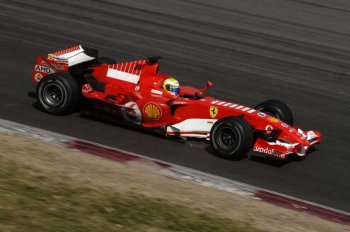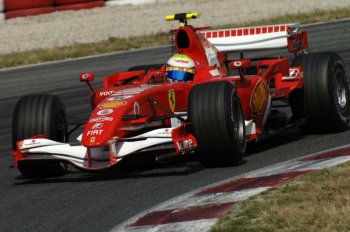|
One of the many
job descriptions that did not exist in Formula 1 a few years
ago is Performance Engineer, a title given to someone whose
job it is to oversee all aspects of the car's performance in
order to back up the more subjective dialogue between Race
Engineer and driver with hard facts about the car.
Giuliano Salvi
is the man who fills this role for Felipe Massa and for him,
the complexities of the Circuit de Catalunya make this one
of the most stimulating weekends of the year. "If we
consider Barcelona as one of the more modern circuits, then
it has to be said it is one of the more interesting," says
Salvi. "This is because it combines a slow section, with
tight corners like Turn 5 and 10 which are very slow and
challenging from a traction point of view and old style very
high speed corners, like 12, 13, 3, 9 which are rarity on
the relatively new tracks. Therefore it is quite complicated
to get the car set up correct. You have to find a compromise
between a car that is good in the quick parts and the slow
ones."
Salvi has a
degree in Aerospace engineering, but like so many students
of this subject he preferred to put his expertise to work
with wheeled rather than winged machines and his first job
was in the DTM touring car series in Germany for a couple of
years. "Then I joined Ferrari to work with the customer
teams," says Salvi, taking up the story. "We were supplying
Prost in 2001 and I was in charge of the gearbox, as that
was my department, until the end of the Prost era. From
there I went to the Scuderia's test team. In 2002, I was in
charge of gearbox and hydraulics for the test team. Then, in
2003, I became a Performance Engineer until 2005 in the test
team and then this year, I now work with Felipe Massa in the
same role. I was already his Performance Engineer in 2003,
when he was our test driver. So I have worked with him since
2000, because when I worked in DTM I was also involved in
the German F3 series and we became friends then."
As to the
characteristics of the Spanish track, they tend to deliver
high speed understeer. "So you need a stable car that is
very quick through the final two corners of the lap, to
launch yourself down the main straight which follows, which
is over a kilometre in length," explains Salvi. "But you
cannot just set up the car to be good here as for much of
the time, it also has to cope with those slow corners I
mentioned. It gives the engineers a hard time as they work
on this compromise."
Barcelona, in
its five kilometres, has a real cross section of corner
types and it is this variety which is the most interesting
feature of the circuit. "You can play with the levels of
aerodynamic downforce, as you have a long and very fast
straight, where you can pick up speed and time, but that
requires you to be quick through Turns 12 and 13," analyses
Salvi. "So you have to work on the aerodynamics and set-up,
which can vary a lot. Not for nothing do all the teams come
here for winter testing because it is a track where you can
get a lot of useful data. A car that works well at Barcelona
works well almost everywhere." Indeed, Barcelona is probably
the most widely used test track, so apart from the overall
job of moving forward with the development of the car,
engineers have to bear in mind that this is a venue for a
grand prix and therefore some of the testing has to be more
race specific.
|
 |
|
"If we consider Barcelona as one of the more modern
circuits, then it has to be said it is one of the
more interesting," says Salvi. "This is because it
combines a slow section, with tight corners like
Turn 5 and 10 which are very slow and challenging
from a traction point of view and old style very
high speed corners, like 12, 13, 3, 9 which are
rarity on the relatively new tracks. Therefore it is
quite complicated to get the car set up correct. You
have to find a compromise between a car that is good
in the quick parts and the slow ones." |
|
|
 |
|
One of the many job descriptions that did not exist
in Formula 1 a few years ago is Performance
Engineer, a title given to someone whose job it is
to oversee all aspects of the car's performance in
order to back up the more subjective dialogue
between Race Engineer and driver with hard facts
about the car. |
|
|
"We keep in mind
the fact we will be back to race here and the most important
aspect to deal with is our understanding of tyre
performance," continues Salvi. "We need to try and get the
tyre that gives the best performance which naturally tends
to be the softest compound possible, while lasting the
distance over what we expect to be our longest stint in the
race itself. So within the range we have established from
our experience at this track, we try and push that to a
softer tyre to see if we gain in performance and in grip.
But one reaches a point where the driver can lose confidence
in the way the car is behaving, even though he is being
offered more grip. This is down to the moving sensation he
feels, where although the tyres are stuck to the track, the
chassis moves on its tyres. This comes with a tyre that is a
fraction too soft and does not mean the car itself is
unstable. So, in this situation, even if the car has more
grip, the driver tends to go a bit slower. The car is more
unstable on the tyres and it is hard to tell for the driver
what the car is doing. "
A softer tyre
might produce a better grid position, but if for whatever
reason a driver finds himself further back than is ideal,
this track does offer overtaking opportunities. "You can try
Turn 1 after the straight," says our Performance Engineer.
"The difficulty here is that, if you are following a car
closely out of the last turn onto the straight, you lose
downforce, so you have to regain it as quickly as possible
in the second half of the straight, in order to pass going
into Turn 1. Then there is Turn 4 which again follows on
from a fast corner, but the best place of all for passing at
this track is Turn 10, which for the past few years has been
a much sharper corner than it was in the past and thus
promotes overtaking as the braking for this turn is very
heavy with extremely high longitudinal G forces. So if you
come out of Turn 9 well, you can get past."
If the layout of
the circuit does not already provide plenty of food for
thought for engineers, the elements can also add to the
complexity. "The wind plays a key role at this track,"
reveals Salvi. "Naturally, it has an effect on what gear
ratios you chose, but most of all when the wind blows almost
directly across the main straight, the new enclosed
grandstand in the shape of the "C" of Catalunya, which goes
up to halfway along the main straight, creates a big
problem, as it blocks the wind. While a driver is alongside
the grandstand, he is protected from the wind, but as he
comes out from its shadow, the wind creates instability in
the car. So it is important to understand where the wind is
coming from."
For this year,
Giuliano finds himself reunited with Felipe Massa with whom
he worked when the Brazilian was an official test driver for
the team. "He has changed a lot since then, especially when
he came here for the first time he had a few rough edges,"
reckons Salvi. "During his year in our test team he learnt a
lot, becoming more involved in the technical side of the car
and so he was able to return to the race environment. He has
grown a lot already this year, race by race. He is growing
in confidence. For sure it can be scary to have Michael as
your target, but it is also a resource because if you can
match Michael you are doing very well. We are trying to
emphasis the positive side of having Michael as a team-mate
and it is good for his career."
|
|
|
|
![]()
![]()